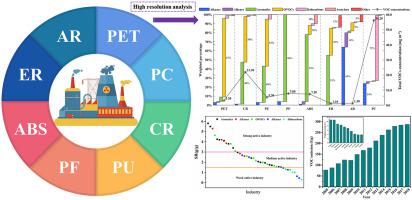Environmental Pollution ( IF 7.6 ) Pub Date : 2021-09-28 , DOI: 10.1016/j.envpol.2021.118253 Yiran Ma 1 , Shaqi Fu 1 , Song Gao 2 , Shuwei Zhang 1 , Xiang Che 3 , Qiaoming Wang 4 , Zheng Jiao 1

|
The synthetic resin industry plays an important role in Volatile organic compounds (VOCs) emissions from industrial sources. However, owing to various products and their different emission characteristics, it is extremely difficult to study the source profiles of synthetic resins. In this study, the product-based pollution characteristics of VOCs from eight synthetic resin enterprises were investigated in Shanghai, China. Up to 133 VOCs were identified, including 106 based on the Photochemical Assessment Monitoring Stations (PAMS) and the Toxic Organics (TO-15) methods, and the remaining 27 were identified based on the new mass spectrometry analysis method. Aromatics (39.7%) and oxygenated VOCs (29.9%) accounted for a relatively high proportion in the synthetic resin industry. The product-based source profiles of each process unit are compiled. Generally, 1,4-dioxane, methyl isobutyl ketone, toluene, benzene, styrene, propane, and dichloromethane are the most abundant species in synthetic resin. Furthermore, the product-based ozone formation potentials (OFPs) and sources reactivity (SR) were calculated, the synthetic resin industry SR range from 0.3 g g−1 to 4.6 g g−1. Results suggest that toluene, benzene, styrene, propylene, ethylene, and oxygenated VOCs (including 1,4-dioxane, methyl isobutyl ketone, and aldehyde) should be preferentially controlled to reduce the OFPs. A three-level classification was established to evaluate the degree of photochemical pollution in different industries. Emission factors were calculated and ranked for eight synthetic resins. A VOC emission inventory of Chinese synthetic resin from 2005 to 2018 was compiled. It is estimated that the Chinese synthetic resin emitted 23.96 Gg of VOCs in 2018. In this study, a product-based VOC source profile and emission inventory of the synthetic resin industry were established for the first time. Finally, combined with product types, processes, and processing equipment, feasible recommendations for reducing VOC emissions in the synthetic resin industry are proposed.









































 京公网安备 11010802027423号
京公网安备 11010802027423号